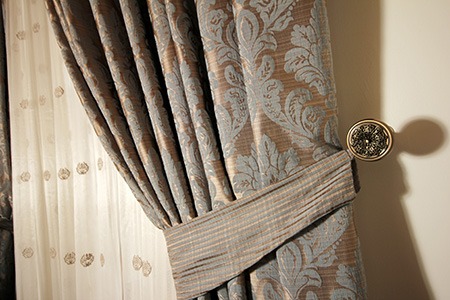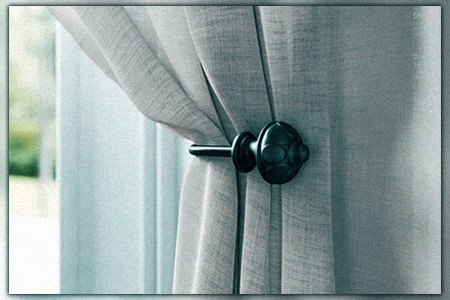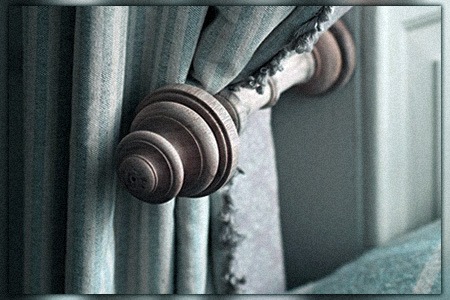Where to Place Curtain Holdbacks for a Sleek Decor
Author: Rick Worst | Editor: Omar Alonso
Review & Research: Jen Worst & Chris Miller

Is there anything more satisfying than hanging a new set of curtains in the living room or bedroom? Curtains are functional, but they also serve a decorative purpose. When you draw back the curtains in the morning, how they're positioned brings an elegant design aesthetic to the room. But where to place curtain holdbacks is a question many begin to wonder.
Using a holdback for the curtains allows you to shape them to bring a unique look. If you're going for a traditional, regal look, a holdback enables you to create a puddle on the floor or graze it. Knowing where to install curtain holdbacks on a wall lets you get the look you want in the room.
Typically, you'll place holdbacks a third of the way up the wall from the floor, and positioning it higher or lower creates a symmetrical look. There's more to correct curtain holdback placement than you think, and this post unpacks everything you need to know to make you the décor master.
What's The Difference Between Holdbacks & Tiebacks?

The curtain holdback offers a convenient way to open the curtain without drawing the curtain back along the curtain rail. It creates a stylish, decorative look to the window treatment, bringing more design functionality to lounges, bedrooms, and dining rooms.
A wall-mounted holdback is a solid structure made from wood, steel, or iron, and you don't have to use a rope or tieback to position the curtain. Instead of battling to loop the tieback around the curtain, you simply slot the curtain into the holdback.
Tiebacks can be cumbersome to use, and they don't always have as classy a look as a holdback. That's the key thing to consider between holdbacks and tiebacks.Tiebacks are better suited to the kitchen and bathroom, where you close the curtains less often. Tiebacks can also create creases in your curtains, making them less visually appealing when open.
Wall-mounted curtain holdbacks are ideal for stationary windows, and they also work well when paired with curtain rods on sliding doors. A sliding glass door allows people outside to peek into your home, with no visual barrier offering you privacy.
Installing curtain rail solves this problem, but it becomes annoying when you have to draw the curtains every time you move in and out of the door. A holdback allows you to tuck the curtains out of the way, giving you easy access to the door when moving in and out of the room, no matter the types of curtains used.
How to Install Curtain Holdbacks – A Step-by-Step Guide

How you position the holdbacks in terms of the height from the floor and the distance from the edge of the wall makes a difference in the look of the curtain. You'll need to consider factors like how close to the trim you want the holdback to give a specific look to the curtain and consistency in positioning the holdbacks on the wall.
Before fixing the holdback to the wall:
- Fit the curtain into the U-shaped cavity and position it on the wall.
- Slide it up and down and further or closer to the edge of the window to get an idea of the look you want to create.
- Experiment with different heights and widths and ask someone to hold it in place while you step back from the curtain and get a wider view of the look it creates.
The general rule of thumb for where to place curtain holdbacks is that if you prefer a fuller look at the top of the curtain, fit the holdback around a third of the way up the curtain from the floor. If you want a fuller look from the bottom, position the holdback a third of the way from the curtain rail.
The rule of thumb for positioning the holdback from the edge of the window is between one and six inches. The closer it is to the edge, the more of the window it covers when the curtains are in the holdbacks.
The holdbacks must be evenly spaced on both sides to make a decorative, symmetrical, aesthetic statement. Ensure you use a spirit level when installing them to keep the holdback parallel to the floor. Use a measuring tape to ensure you have equal spacing from the edge of the window on both sides.
While you can certainly dress a window without curtains, it just looks so much nicer done up properly. Here's a step-by-step guide to installing curtain holdbacks for the best results.
1) Measure the Length of Your Curtains
The first step in successfully installing your holdback placement is measuring the curtains. Start from the point at the bottom of the curtain where it hangs. That means taking the measurement from the eyelet for eyelet curtains or from the pleat in pleated curtains. Measure down to the floor and divide the measurement into thirds.
2) Set the Height of Your Holdback
When you get the measurement, take it from the floor and mark it a third of the way up the wall using a pencil. Make the marking at least three inches from the edge of the wall or window pane. You can go up higher if you prefer but don't get as high as one-half.
Also, this is based on the length of the space on the wall covered by the curtain, not the length of the curtain itself. I say this because some people don't like their curtains touching the floor and some like them pooled up in a puddle on the floor, too.
For instance, if you have a curtain measuring 84 inches from the eyelet to the floor, the correct positioning of the holdback (according to the rule of thumb guideline) is 28 inches from the floor.
3) Position the Holdback
After choosing and marking the ideal position for the holdback:
- Have someone hold it for you with the curtain in place.
- Step back into the center of the room and examine the look.
- Have them move the holdback up or down and further or closer away from the wall until you have a perfect position and the right design aesthetic that pleases you.
When you find the right spot where to place curtain holdbacks that looks ideal to you, mark the position using a pencil. Take your measuring tape and record the measurements. Complete the same markings on the other side of the wall. Ensure you're using your spirit level to keep the holdback parallel to the floor when taking measurements and markings.
4) Install the Holdback
The holdback comes with the hardware you need to position it in place. In most instances, you'll need a power drill, drill bits, and fasteners to secure it to the wall. Ensure your marking are correct before drilling into the wall.
Top Tips for Styling Curtain Holdbacks

Follow the below tips to make sure your decor comes off correct and not sloppy or naive.
Secure the Top of the Panels With Safety Pins
If you want to create a style statement and a regal look to the curtains in the holdbacks, use a safety pin to secure the curtain panels together at the top.
This means when you release the curtains from the holdback, they fall into the closed position. This styling creates a sweeping look to the curtains when they're positioned in the holdbacks.
Place the Holdback Halfway With Short Curtains
If you have short curtains, position the holdback halfway up the wall. With the one-third rule, a short 36-inch curtain requires a holdback 12 inches from the floor. Placing it one-third of the way from the bottom means the curtain will blow out of the holdback if wind gusts through the window.
Create Puddled Drapes by Placing the Holdback Higher-Up
If you're using puddled drapes, positioning the holdback one-third of the length from the floor creates too much loose fabric when the drapes are in the holdback. It creates a loose look that blocks out too much sunlight from the room. Place the holdback halfway up the wall for the right visual.
FAQ’s Regarding Curtain Holdback Placement

Let’s cover some more common questions that arise during a discussion regarding where to place curtain holdbacks.
Should Curtain Holdbacks be Angled?
No. There are "post" styles that are designed to stick out perpendicular from the wall. Others that have the shape of a hook should be parallel to the floor and perpendicular from the wall. Do not angle your curtain holdbacks.
How Far Should Curtain Holdbacks Be From the Wall?
The rule of thumb for correct holdback height is two to three inches from the side of the wall and around a third of the length of the curtain from the floor. You can position the hold back up to six inches from the wall to bring more light into the room and make the space seem larger.
What's the Difference Between Curtain Holdbacks & Tiebacks?
A curtain holdback is a fixture made from steel, iron, or wood. It's a solid component featuring a U-shape to which you fit the curtain. It's common to find holdbacks in lounges, dining rooms, and bedrooms. A tieback is a piece of rope or fabric you connect to a fixture on the wall. It serves the same function as a holdback but holds the curtain differently.
What's the Correct Length for Curtain Tiebacks?
The ideal length of a curtain tieback is from the floor to your waist, but not below. If the tieback reaches your rib cage, it's too long.
Key Takeaways Regarding Where to Place Curtain Holdbacks

Let’s recap the main points from above:
- Curtain holdbacks have a practical and aesthetic function in the bedroom, dining room, and lounge.
- The general rule of thumb is to position the holdback a third of the curtain length from the floor.
- The holdback should be positioned between one to six inches from the edge of the window wall.
- Holdbacks come in materials like wrought iron, wood, and steel.
- A holdback suits all styles, so curtains. You can create a regal look for curtains by pinning them together at the top in the closed position. This style creates a swooping look to the curtains when they're in the holdback.
- For shorter curtains, position the holdback halfway up the wall to prevent the wind from blowing them out of the holdbacks.
- Remember to measure accurately during fitment, and use a spirit level to keep the holdback parallel to the floor.
It’s not hard to get the right curtains tie backs height when following the points above. In fact it’s very simple. But don’t be rigid and feel like you can’t break these rules to more appropriately suit your own space. This is art, not science, when it comes to where to hang curtain holdbacks.
And That’s Where to Place Curtain Holdbacks
Just remember the rule of thumb regarding where to place curtain holdbacks: they’re to be installed at one-third of the height of the curtain starting from the ground. I would say that even two-fifths is still appropriate but definitely try to be below the one-half mark if you can.



